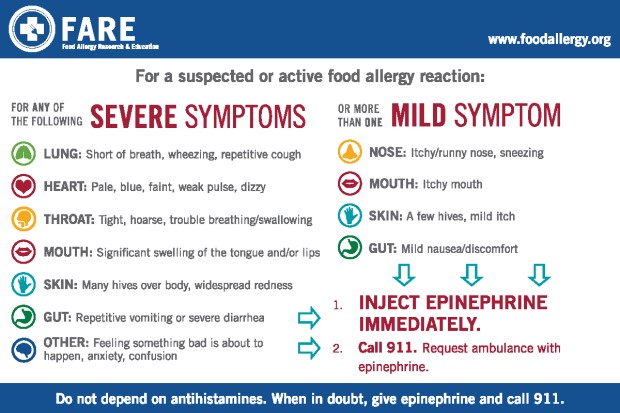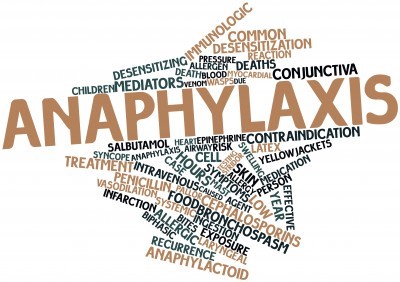Introduction
Overview
Anaphylaxis is an allergic reaction to a food, an insect bite, or medication. This manual describes how to diagnose, treat, prevent, and call for help when coming across someone who is having an allergic reaction.
For example, your daughter is at school and decides to trade her sandwich with a friend. In her sandwich is peanut butter, a new flavor your child has never known. Suddenly, her face suddenly starts to swell and she has trouble breathing. How should a teacher or adult react?
Learn the signs, symptoms, treatments to act. One of the treatments described in this manual is called an EpiPen. One quick injection and in thirty seconds or less and your child can breathe again. Parents with a child that has a family history of anaphylaxis, such as to bee stings or certain food allergies, should carry one with them always.
Who and Why Should Use this Manual
This manual is recommended for everyone and is written as an easy to follow guide on what to do in case of an anaphylaxis emergency. This manual uses various media and tools to help the reader understand and recognize the symptoms of anaphylaxis; provide treatment, if necessary; and call for help. Information in this manual could one day save the life of someone close to you.
Prevention
Anaphylaxis: Anaphylaxis is a severe, potentially life-threatening allergic reaction. It can occur within seconds or minutes of exposure to something a person is allergic to, such as peanuts or the venom from a bee sting.

Food Allergies: Food allergies can cause anaphylaxis. Foods most likely to cause a severe reaction are peanuts tree nuts, fish, and shellfish. People who have both asthma and a food allergy are at greater risk for anaphylaxis.
Physical Activity: Exercise-induced anaphylaxis (EIA) is a rare disorder in which anaphylaxis occurs after physical activity. Intensive forms of exercise include running, dancing, and bicycling are more commonly associated with exercise-induced anaphylaxis; although lower levels of exertion walking and yard work are also capable of triggering attacks. Exercising in cold weather maybe of special risk.
Medication: Penicillin and other antibiotics are common medication that people have allergic reactions to.
The best way to prevent anaphylaxis is to avoid substances that can cause a severe reaction and by taking the following precautions.
- Wear a medical alert necklace or bracelet to indicate if you have an allergy to specific drugs or other substances.
- Alert your doctor to your drug allergies before any medical treatment.
- Contact your child’s school and inform them of any known allergies.
Example of Prevention:
Consider the situation where you are the parent of a child who has a food allergy and is just starting school. The following describes the precautions a parent can take to keep their child safe, in the event of an allergic reaction.
The responsibilities of you as a parent are to meet and discuss accommodations that will ensure the safety of your child. This includes identifying actions, educating staff, and providing medication to treat the condition, if necessary.
Signs
Signs and Symptoms of Anaphylaxis:
Signs are indicators of a problem. They also include breathing rate, heart rate, oxygen saturation, etc. Some of the most common signs in the medical field are the skin signs: color, temperature and moisture. People who are pale, cool and moist are usually feeling pretty bad.
Symptoms can only be described by the person feeling them. An example: is the patient feeling lightheaded, dizzy, fatigue.
Signs in anaphylaxis include rapid, weak pulse, a skin rash, and nausea and vomiting. Common triggers of anaphylaxis include certain foods, some medications, insect venom, and latex.

Symptoms
An early symptom is immediate sense of apprehension and anxiety. The patient may first feel a tightness in their chest. A very prominent symptom would be generalized itching usually more prominent on the torso. The person may feel vague nausea and abdominal cramping. There could also be some difficulty swallowing. For symptoms, there may be a weak and fast thready pulse, the blood pressure could be very low, and the respiratory rate very fast making the patient appear short of breath. The patient may be developing hives almost immediately. The patient appears very apprehensive. The patient’s lips may be blue with cyanosis, and this may rapidly spread to other mucous membranes. The blood pressure may be low, but if very anxious, the blood pressure maybe very high.

Warnings: Anaphylaxis requires an immediate trip to the hospital emergency department and an injection of epinephrine. If anaphylaxis isn’t treated right away, it can lead to unconsciousness or even death.
Additional definitions can be found here: http://www.mayoclinic.org/diseases-conditions/anaphylaxis/basics/definition/con-20014324
Medication
The Epipen and Three steps to Save a Life
Epipen®: a brand name for an epinephrine auto-injector device used to manage potentially life-threatening anaphylactic reactions to allergens. Epinephrine is the first-line treatment for life-threatening allergic reactions.
Types of Epipens: EpiPen® 0.3 mg and EpiPen Jr® (epinephrine injection, USP) 0.15 mg

Instructions:
3 Call 911
In an Emergency
Call 911
Most people will call 9-1-1 only once or twice during their lifetimes. Having the necessary information will help the 9-1-1 operator in sending you the appropriate help quickly. It can be a frightening experience, but there are several precautions that you can take to make the process run smoothly for you and the operator.
Steps:
- Don’t panic. Obviously, when you are making a call to emergency services, you are in an emergency, and have a lot of adrenaline flowing through your veins. However, this will impede your speech and may cause you to start talking too fast, too slow, begin stuttering, etc. Make sure you are far enough away from the emergency to be safe unless someone is badly hurt.
- Find a phone. Preferably a land line unless it’s a fire or burglary. This will help determine your location. If it’s a fire, don’t stay in the building, get out first.
- Call 911. Pick up the receiver and dial 911. Be aware that, sometimes, it takes time for the phone to route to the correct answering point. Do not hang up if you do not connect immediately!!
- Do not panic. This is easier said than done. Panic does not help. Instead, begin to plan what you will say to the dispatcher (see below). Remember: Panic is the enemy, in this race against time.
- Know what you will be asked. Make sure that you are aware of each of the following:
- Where is the emergency? The emergency is not always located where you are calling from. Always be aware of your surroundings and where you are. Try to keep a watch out for the road signs, business names and intersections whenever you may travel.
- Nature of the emergency: Do you require assistance from law enforcement, medical professionals, and/or fire fighters? In certain areas, the dispatcher or a computer will tell you to dial certain numbers to help them know which department to connect you with and whom you should talk to.
- A detailed, yet concise, description: What happened? How many details do you know? What should have the most importance? In general, the most important thing is why you need assistance.
- The phone number of your phone. The dispatcher will need instructions on how to get to where you are, and may need to call back for more information. Know the phone number of your phone.
- Give the dispatcher your name and address.
- Listen to the dispatcher. Follow orders. The better and faster you follow orders, the higher everyone’s rate of survival will be. Even in a non-lethal situation (broken bones, etc.) this is of vital importance. Have strict, unwavering faith in the dispatcher. And remember that even if the dispatcher is still asking questions or giving instructions, help is on the way.
- Do not hang up until instructed to. Anything can happen, and the emergency services need to know your situation at all times.
Resources
EpiPen Product Information:
http://www.accessdata.fda.gov/drugsatfda_docs/label/2016/019430s061lbl.pdf
YouTube Video: https://www.youtube.com/watch?v=8OTvrgiBSqE
How to Use an EpiPen
Online Technical Manual: https://anaphylaxisinfo.wordpress.com/
